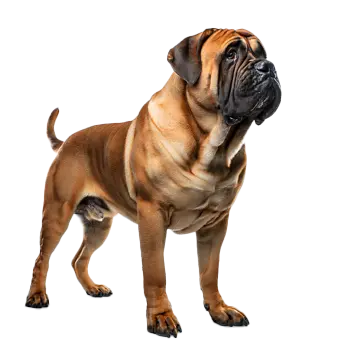The history of the Gamekeeper's Nightdog begins in the tumultuous social and economic landscape of mid-19th century England, where rapid industrialization and changing class structures created unique challenges for landowners trying to protect their estates from increasing poaching activities. During this period, English gamekeepers faced mounting pressure to develop effective methods for deterring and capturing poachers who threatened valuable game reserves and private property rights.
The breeding program that would eventually create the Gamekeeper's Nightdog emerged around 1860 as a direct response to the inadequacies of existing dog breeds for estate protection work. Traditional English Mastiffs, while impressively large and intimidating, proved too slow and cumbersome for pursuing agile poachers across varied terrain. Conversely, Old English Bulldogs possessed the necessary courage and tenacity but lacked the size and strength required to physically subdue adult criminals.
English gamekeepers, working in collaboration with progressive estate owners, embarked on a systematic breeding program designed to combine the best characteristics of both breeds. Through careful selection and strategic crossbreeding, they developed a formula that called for approximately 60 percent English Mastiff bloodlines and 40 percent Old English Bulldog genetics. This precise ratio proved critical in achieving the desired balance of size, courage, intelligence, and temperament necessary for effective estate protection.
The working requirements that shaped the breed's development were extraordinarily specific and demanding. These dogs needed to operate silently during nighttime patrols, track human scent across diverse terrain, possess the courage to confront armed and desperate criminals, and demonstrate the physical capability to knock down and restrain adult men without inflicting lethal injuries. Additionally, they required the intelligence to distinguish between legitimate estate personnel and unauthorized intruders, as well as the temperament to live harmoniously with gamekeeper families.
The early development phase of the breed was characterized by intense practical testing under real-world conditions. Gamekeepers would evaluate dogs based on their performance during actual anti-poaching operations, selecting only those individuals that demonstrated the ideal combination of working traits for further breeding. This rigorous selection process ensured that temperament, intelligence, and physical capabilities remained closely aligned with practical working requirements.
As the breed's effectiveness became apparent, word of the "Gamekeeper's Night Dog" spread throughout English sporting circles and landed gentry. Estate owners began specifically requesting these dogs for their properties, leading to increased demand and more systematic breeding programs. The breed's reputation was enhanced by numerous documented cases of successful poacher apprehension, establishing their credibility as practical working animals rather than merely impressive guard dogs.
The transition from purely functional working dog to recognized breed occurred gradually throughout the late 19th and early 20th centuries. As poaching pressures decreased due to changing social conditions and improved law enforcement, the Gamekeeper's Nightdog began finding new roles as estate guardians, family protectors, and eventually show dogs. This evolution required careful attention to maintaining the breed's essential working characteristics while adapting to changing social expectations.
The formal recognition process began with The Kennel Club of England in 1924, marking the first official acknowledgment of the breed as a distinct type rather than simply a working crossbreed. This recognition required establishing minimum standards for breeding eligibility, including the requirement that dogs have at least four generations of documented lineage without outcrossing to the original parent breeds. This standard helped stabilize breed type and ensure consistent characteristics across different bloodlines.
International recognition followed relatively quickly, with the American Kennel Club accepting the breed in 1933 and establishing the first American breed standard in 1935. The timing of American recognition coincided with increasing interest in guard dog breeds during the economically uncertain 1930s, when property protection became a priority for many Americans. Early importers worked diligently to establish quality breeding programs that maintained the breed's essential characteristics while adapting to American conditions and preferences.
The breed's role during the mid-20th century expanded beyond traditional estate work to include various security and protection functions. During World War II, the breed served in military and civil defense roles, while the post-war period saw increased interest in personal and family protection dogs. This diversification of function helped establish the Gamekeeper's Nightdog as a versatile working breed suitable for various protective roles.
A significant milestone in the breed's international recognition came in 1955 when the Fédération Cynologique Internationale granted definitive acceptance, establishing standardized guidelines for breeding and exhibition across member countries. This recognition facilitated international cooperation in breeding programs and helped maintain consistency in breed type across different geographic regions.
The modern era of Gamekeeper's Nightdog development has been characterized by increased attention to health testing, genetic diversity, and adaptation to contemporary family life. Breed organizations worldwide have implemented comprehensive health screening programs addressing known genetic issues, while breeders have worked to maintain the breed's essential working characteristics while producing dogs suitable for modern family environments.
Contemporary breeding programs face the ongoing challenge of preserving the breed's guardian instincts and physical capabilities while producing dogs that can adapt to suburban and urban environments. This balance requires careful selection for temperament stability, trainability, and social adaptability without compromising the natural protective instincts that define the breed's character.
The breed's history continues to evolve as modern Gamekeeper's Nightdogs find new roles in personal protection, therapy work, search and rescue operations, and competitive dog sports. This adaptability reflects the intelligence and versatility that the original breeders bred into the line, demonstrating that the qualities that made these dogs exceptional estate guardians continue to serve them well in contemporary applications.
Today's Gamekeeper's Nightdog represents nearly two centuries of careful breeding and selection, maintaining the essential characteristics that made them legendary among English gamekeepers while adapting to serve as beloved family companions and guardians in modern society. Their history stands as a testament to the success of purpose-driven breeding programs and the enduring value of dogs bred for specific working functions.

